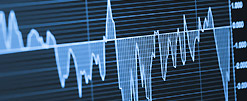

THE HISTORY OF FOREX TRADING
19th December 2019
The global forex market is the largest of all financial markets, with average daily volumes in the trillions of dollars. It also operates on some of the most advanced technology around. Billions of dollars in trades can be executed in seconds by traders from every corner of the world.
But, how did it all start out, and how did it evolve into the market we know today? The history of currency trading is, of course, the history of money. So, we need to start off by looking at the origins of money.
The origin of money
Money itself is believed to have originated in Babylonia nearly 4,000 years ago. Before then, goods were always exchanged for other goods. Fish, livestock, crops, cloth, and spices were all exchanged directly in return for one another. This type of trade was obviously impractical at times. You could only store wealth to spend later by buying something that wasn’t perishable. Transporting wealth was also impractical.
It seems plausible that people who knew one another would have used a system of IOUs at that time. This may have worked within a small community but wouldn’t have worked for travelling traders or merchants.
Initially, pieces of metal, shells, precious stones and spices were used as a form of currency. Around 2,500 years ago, the first coins were made. Over time, gold and silver coins became the standard form of money throughout the Middle East and around the Mediterranean.
Coins were valued according to their weight and what they were made from. Coins minted in different parts of the world were exchanged by money changers who operated in market stalls. These people were the world’s first foreign exchange brokers and bankers.
Global trade
During the middle ages, Amsterdam and Florence were the most important centres for global trade. In order to accommodate trade involving several currencies, a more complex banking system evolved. This enabled merchants to draw local currency against their holdings with foreign banks.
By the 1700s, foreign exchange markets existed in all major economies. In the US, early investment banks began to trade currencies for their own account and for client accounts. This was still very different from today as coins were issued by banks and weren’t all identical. In addition, bills of exchange and other types of promissory notes were used as currency.
Today we are used to silver and gold being priced in US dollars or other currencies, but during the 1800s, it was the other way around. Silver was the benchmark against which everything else was measured, including the gold and the dollar. Foreign currencies and any other form of currency were always valued against silver, and currency trades were priced on that basis.
The gold standard of money
The original silver dollar became the official currency of the US in 1785. A dollar was set at 24.06 grams of pure silver. At the time, most countries standardized their currencies as a specific weight of either gold or silver.
Paper money was first issued in 1862 in the US, though it had been used earlier in China and other parts of the world. At the time, paper money represented gold or silver in a bank vault. Paper money was actually issued by banks as a receipt for gold or silver kept on deposit at the bank.
In 1900, the gold standard was adopted, and one US dollar was set at 1.5 grams of gold. Most countries followed suit, making gold the standard against which all currencies were valued.
After the gold standard was adopted, the British pound became the world’s benchmark currency, and most currency trades involved the pound. This happened because most trades flowed through banks in London. Exchange rates were transmitted between London and New York via an undersea cable, hence the GBPUSD rate is still referred to as “Cable.”
Bretton Woods and the beginning of fiat currencies
The Bretton Woods Accord was signed in 1944 and allowed central banks to let currencies fluctuate within one percent of their gold-backed value. This gave central banks more flexibility and allowed supply and demand to affect exchange rates.
After 1971, the US gradually abandoned the gold standard, and other countries soon followed suit. Currencies then became fiat currencies, and their values were left to market forces as well as central bank policy. A fiat currency has no intrinsic value but can have value because of the way it fits into a financial system.
The modern currency market
Widespread forex trading only really took off after the gold standard was abandoned and currencies could float freely. However, it is technology that has really shaped the forex market we know today.
The first electronic forex quotes were made available by Reuters in 1973. Various other quote machines were introduced after that, but it wasn’t until the internet came along that individual investors had access to live forex prices.
Since the mid-1990s, faster and cheaper technology and internet access have democratized the market. Increased competition has also contributed to narrower spreads and lower trading fees.
With the cutting-edge technology and narrow spreads available today, it's hard to imagine the forex market evolving even further. It may be the currencies themselves that change, as we are seeing with cryptocurrencies. Whatever happens, it’s apparent that currency trading has come a long way since ancient Babylonia.
Begin trading today! Create an account by completing our form
Privacy Notice
At One Financial Markets we are committed to safeguarding your privacy.
Please see our Privacy Policy for details about what information is collected from you and why it is collected. We do not sell your information or use it other than as described in the Policy.
Please note that it is in our legitimate business interest to send you certain marketing emails from time to time. However, if you would prefer not to receive these you can opt-out by ticking the box below.
Alternatively, you can use the unsubscribe link at the bottom of the Demo account confirmation email or any subsequent emails we send.
By completing the form and downloading the platform you agree with the use of your personal information as detailed in the Policy.






